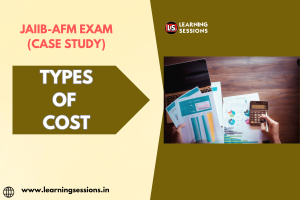The JAIIB Accounting and Financial Management (AFM) module highlights key financial principles, and one of the most fundamental concepts is understanding the types of cost. In the context of banking and financial institutions, distinguishing between different types of costs is critical for managing profitability, improving operational efficiency, and making informed strategic decisions. Learning Sessions provides this article that will explore the various types of cost, supported by a case study, to demonstrate their relevance in a banking environment.

📚 JAIIB Study Resources 📚
👉 Check Here
👉 Check Here
👉 Check Here
👉 Get Tests Here
👉 Check Here
DOWNLOAD PDF TYPES OF COST -CASE STUDY
Cost classification is essential for any business, and especially for banks, as it helps to break down expenses into manageable categories for better control. Here are the main types of cost explored in the JAIIB AFM module:
-Fixed Costs
-Variable Costs
-Direct Costs
-Indirect Costs
-Semi-Variable Costs
-Sunk Costs
-Opportunity Costs
-Marginal Costs
For the extensive preparation of candidates, get details through our YouTube videos for JAIIB AFM Module wise Syllabus with explanations and tips to help candidates in their preparation journey.
You may also like these JAIIB case studies:
JAIIB | AFM | CROSS RATES
JAIIB | AFM | VALUATION OF BONDS
Importance of Understanding Types of Cost in Banking
- Cost Control and Profitability: By accurately categorizing and managing different types of cost, banks can control expenses and improve profitability.
- Strategic Planning and Decision-Making: Understanding opportunity costs and sunk costs ensures that banks make more informed strategic decisions without being influenced by past, irreversible investments.
- Pricing and Efficiency: Evaluating marginal costs is critical for setting prices for products like loans or investment accounts.
- Financial Stability: Accurate cost classification helps banks maintain financial stability during economic fluctuations.
To summarize, The types of cost explored in the JAIIB AFM module are significant for managing a bank’s financial health and profitability. By classifying costs as fixed, variable, direct, indirect, and more, banks can make better-informed decisions, enhance operational efficiency, and achieve long-term sustainability. The case study focuses on how understanding and managing costs play a crucial role in strategic expansion and improving financial performance. Learning Sessions provides additional information about JAIIB AFM SHARE CAPITAL by giving examples of real life scenarios.
Learn more about this case study through our YouTube channel and PDF.
Get access to our Telegram Channel for free Pdfs of JAIIB.







